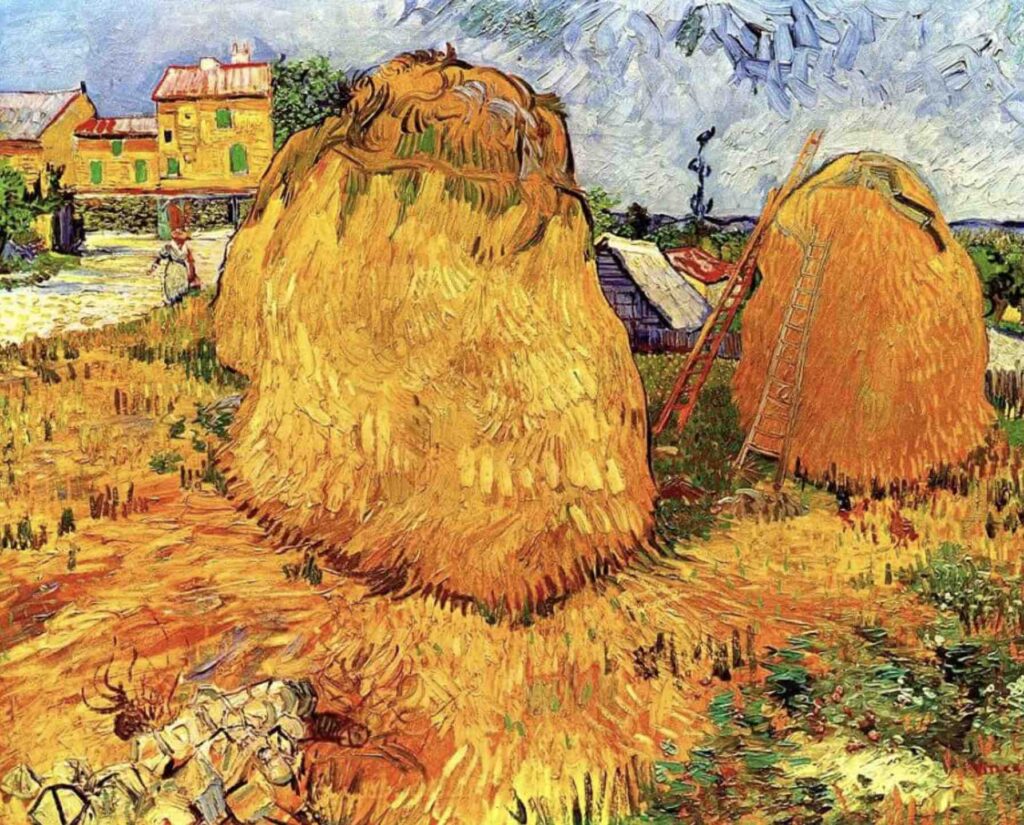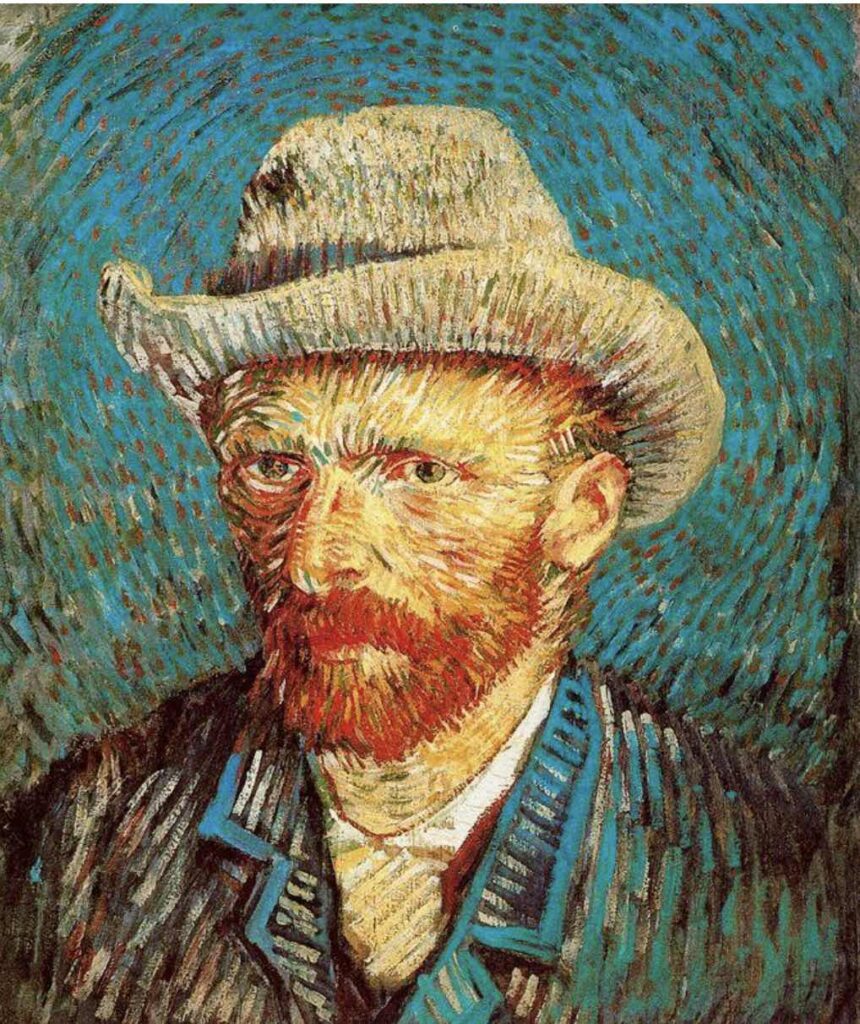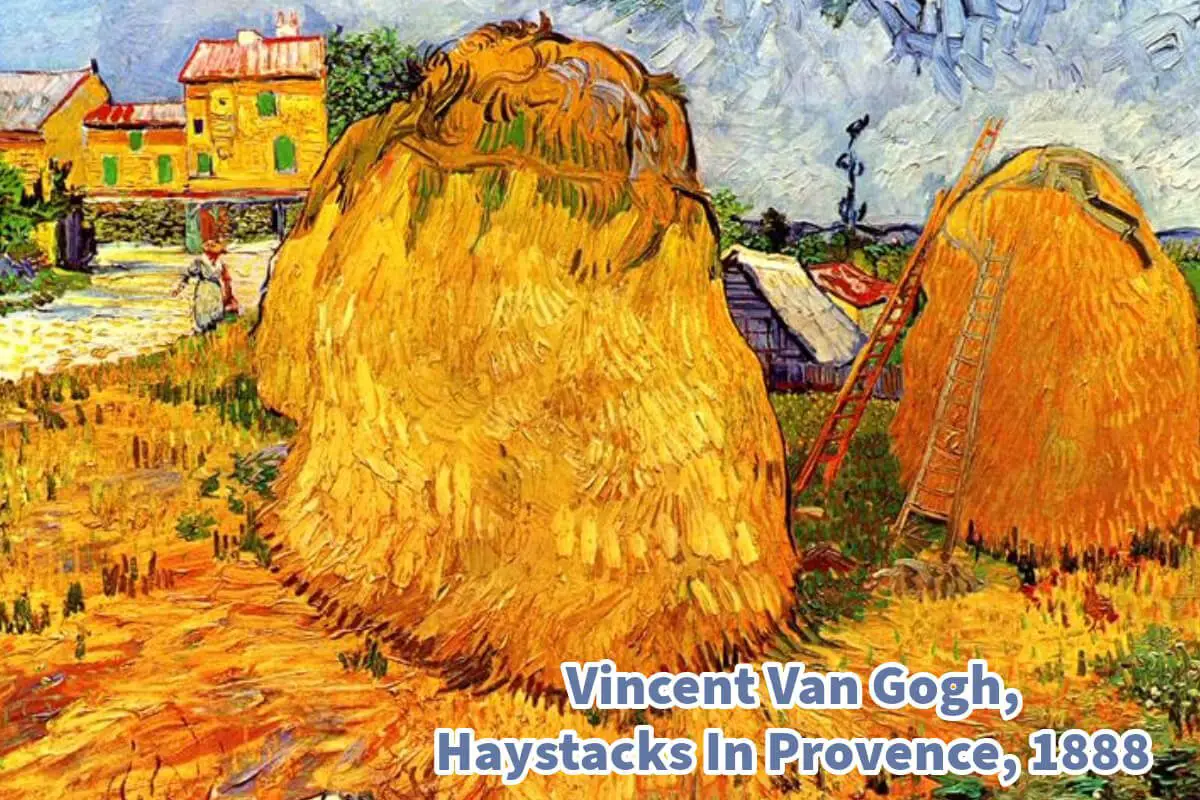Vincent Van Gogh is one of the most exceptional artists in history, inspiring generations of creatives who followed in his footsteps.
Vincent Van Gogh’s artistic prowess is evident in the emotional depth of his works and the vast array of subjects he chose to depict. Among these varied themes is the captivating painting “Haystacks in Provence,” created in 1888. Join us as we delve deeper into this masterpiece and its significance.
Table of Contents
- Vincent Van Gogh’s “Haystacks In Provence, 1888 “: An Intersection Of Color, Technique, And Culture
- The Van Gogh Album That Never Was
- Frequently Asked Questions
- Related Questions
Vincent Van Gogh’s “Haystacks In Provence, 1888 “: An Intersection Of Color, Technique, And Culture
Vincent Van Gogh, synonymous with emotional depth and masterful color application, crafted many artworks that continue to captivate audiences worldwide. Among his extensive oeuvre.

“Haystacks in Provence,” painted in June 1888, offers an enthralling blend of Van Gogh’s characteristic hues, brushwork, and influences. But this painting is not merely an isolated expression; it comes with a companion—a drawing that serves as a testament to Van Gogh’s expertise and lifelong relationship with draughtsmanship.
The Integral Role Of Drawing In Van Gogh’s Artistic Journey
Van Gogh began his artistic career primarily as a draughtsman. Contrary to the common perception that drawings are subordinate to paintings, serving merely as preliminary studies,
Van Gogh treated them as independent exercises in their own right. His drawings often exhibited a rich vocabulary of graphic marks and designs, with each stroke and line meticulously planned and executed.
The drawing accompanying “Haystacks in Provence” exemplifies this richness. It demonstrates how Van Gogh had concurrently been refining his drawing techniques while pushing the boundaries of color in his paintings during his time in Arles.
The drawing is not an afterthought but a parallel commentary exploring texture, form, and expression.
The Influence Of Japanese Art
One of the striking features of this drawing is Van Gogh’s use of a reed pen, echoing the tools used by Japanese draughtsmen. Van Gogh’s fascination with Japanese art was well-documented; he admired their mastery of lines and their symbiotic relationship with nature.
This influence trickles down into his Arlesian works in drawing and painting. He even aspired to collect his Arlesian drawings in an album similar to those he had read about in books on Japanese artists.
The Textures And Techniques In “Haystacks In Provence”
In both the painting and the drawing of “Haystacks in Provence,” Van Gogh employed a variety of strokes and marks to evoke the different textures and characters of each object. The haystacks are not merely mounds but entities possessing distinct textures and hues.
The massive hayricks against the backdrop of a Provencal farm seem alive, almost sentient. In this context, the reed pen’s usage in the drawing serves as an imitation and an innovation, simultaneously respecting traditional tools while appropriating them for his unique style.
The painting offers a cornucopia of colors, serving as a playground for Van Gogh’s explorations of light and shadow.
Each stroke adds another layer of emotional complexity, which, when combined with the fine lines of the drawing, completes a narrative. This narrative can only be fully understood when the painting and the drawing are considered together.

The Van Gogh Album That Never Was
Van Gogh’s idea of collating his Arlesian drawings into an album inspired by Japanese art never came to fruition. Yet, the existence of these individual works tells a story of their own. They exist as pages of an unwritten book, each contributing to our understanding of Van Gogh’s artistic journey.
The painting “Haystacks in Provence” and its accompanying drawing can be seen as chapters in this unrealized album that exemplify his versatility as an artist and his quest for innovation in form and technique.
“Haystacks in Provence, 1888” is more than just a painting; it is a multidimensional experience enriched by its accompanying drawing. By looking at both, we gain deeper insights into Vincent Van Gogh’s artistic process, influences, and mastery of diverse media.
The painting and drawing are mirrors, reflecting different facets of Van Gogh’s artistic brilliance. They offer an invaluable perspective on a man whose life was as textured and complex as the strokes filling his canvas and paper.
From the colors to the reed pen, from the Provencal farm to the influence of Japanese art, each element weaves into a rich tapestry that defines one of history’s most enigmatic and brilliant artists.
Anita Louise Art is dedicated to art education, great artists, and inspiring others to find and create their art. We love art that uplifts and inspires. #ArtToMakeYouSmile! #ArtToMakeYouHappy!
If you want to see any of my art, you can find out more by clicking here. If you are interested in what inspires me and my paintings, you can discover more by clicking here.
We have a free newsletter and would love you to be part of our community; you can subscribe to the newsletter by clicking here. If you have any questions, I would be happy to talk to you anytime. You can reach me, Anita, by clicking here.
Subscribe to our Anita Louise Art YouTube Channel with great videos and information by clicking here.
Join us for our podcast “5 Minutes With Art.” Spend just 5 minutes a week with us to discover and learn about great art and artists. You can find out more about our podcast by clicking here.
Frequently Asked Questions
What inspired Vincent Van Gogh to paint “Haystacks In Provence”?
Van Gogh found inspiration in the picturesque landscapes of Provence, France. The golden fields of haystacks and the vibrant colors of the countryside motivated him to create this masterpiece.
What is the significance of the haystacks in this painting?
The haystacks in the painting represent Van Gogh’s fascination with rural life and agriculture. They serve as symbols of hard work, resilience, and the beauty found in simple, everyday subjects.
How did Van Gogh capture the essence of Provence in this artwork?
Van Gogh used bold, expressive brushstrokes and a vibrant color palette to convey the intense sunlight and the warmth of the Provencal landscape. The play of light on the haystacks adds a sense of dynamism to the painting.
Are there hidden meanings or symbolism in “Haystacks In Provence”?
While Van Gogh didn’t explicitly include symbolic elements, some art historians suggest that the haystacks may represent cycles of life and seasons, echoing the agricultural rhythms of the region.
What techniques did Van Gogh employ in this painting?
Van Gogh utilized impasto, a technique involving thick application of paint, to create texture and depth. The use of complementary colors, especially the contrast between warm and cool tones, enhances the visual impact of the artwork.
How does “Haystacks In Provence” compare to Van Gogh’s other works?
This painting showcases Van Gogh’s evolving style, characterized by bold colors and expressive brushwork. It shares similarities with his famous “Sunflowers” series but reflects his unique interpretation of the Provencal landscape.
Did Van Gogh face any challenges while creating this painting?
During this period, Van Gogh struggled with mental health issues, which added an emotional intensity to his artwork. The intense colors and energetic brushstrokes in “Haystacks In Provence” may mirror the artist’s inner turmoil.
Where is “Haystacks In Provence” currently housed?
As of my last knowledge update in January 2022, the exact location of this painting may vary. It’s advisable to check with museums or galleries housing Van Gogh’s works for the most recent information.
How has the perception of “Haystacks In Provence” evolved over time?
Initially underappreciated, this painting, like many of Van Gogh’s works, gained recognition and acclaim posthumously. Today, it is celebrated for its emotional intensity and contribution to the artist’s unique style.
What impact did “Haystacks In Provence” have on the art world?
Van Gogh’s innovative use of color and brushwork in this painting influenced subsequent generations of artists. “Haystacks In Provence” stands as a testament to his ability to capture the essence of a scene with unmatched emotional power.
Related Questions
Did Michelangelo And Leonardo Know Each Other?
Michelangelo and Leonardo da Vinci knew each other but were considered bitter rivals. Leonardo da Vinci and Michelangelo knew each other, but they did like each other. They were both asked to do a commission on the Council Hall of the Palazzo Vecchio and were supposed to work side-by-side; the project was never completed.
By clicking here, you can learn more by reading Did Michelangelo And Leonardo Know Each Other?.
Michelangelo’s Method To Paint The Sistine Chapel Ceiling
He built a large scaffolding structure that could move around the chapel to paint the ceiling; the painting of the Sistine Chapel was an extremely strenuous work that was a huge personal cost both physically and mentally to Michelangelo.
By clicking here, you can learn more by reading Michelangelo’s Method To Paint The Sistine Chapel Ceiling.
Michelangelo’s Sistine Chapel And His Payment
Michelangelo was paid 3200 gold ducats for his work on the ceiling of the Sistine Chapel, which would have been a very lucrative commission. We know that he stopped work on the ceiling for a while due to his not being paid by the Vatican. Michelangelo liked to give the impression that he was a very poor artist, but records have shown that he died an extremely wealthy man.
By clicking here, you can learn more by reading Michelangelo’s Sistine Chapel And His Payment.

